Compressor for septic tank: principle of operation, how to choose + operating rules
Choosing between a self-made autonomous sewer and an expensive local treatment station, the owner of a private house may ask a question: is a compressor necessary for a septic tank?
This device is used in many industrial VOC models, but they are not used very often in simple sewer devices. In this article, we tried to explain as clearly as possible information about the device and the features of the compressor for the septic tank.
The content of the article:
Features of the functioning of homemade septic tanks
Two types of bacteria are involved in the treatment of effluents produced by local treatment plants: aerobic and anaerobic.
The first species can live and act only in an environment saturated with oxygen, the second exists excellently and performs vital functions in an oxygen-free space.
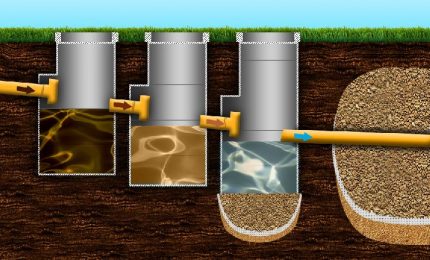
To protect the soil from infection by unprocessed waste mass, the septic tank compartments are sealed. Their walls not only prevent the penetration of bacteria and sewage into the earth, but also block the access of oxygen into the system.
Under such conditions, only anaerobes can exist, and aerobes need to ensure the supply of vital gas.
The septic tank for the needs of a small family consists of two or three sections. In the first section, sewage is sedimented, fermented under the influence of anaerobes and the mechanical filtration of the settled mass is carried out.
In the following compartments, the process is repeated, but the result of multi-stage separation in rare cases reaches 65 - 70%. Therefore, the sewer system with sumps is supplemented with soil post-treatment devices - infiltrators, absorption wells, filter fields.
To increase the degree of processing and provide the possibility of free discharge of water from the septic tank to the topography, anaerobic microorganisms and their ability to digest organics are needed, purifying waste masses by 95-97%. And aerobic organisms need a regular supply of O2. Read more about bacteria for septic tanks Further.
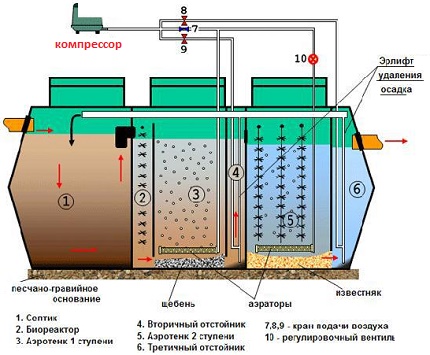
Why do we need a compressor?
This device is necessary to form and move in the right direction the flow of compressed air. Compressors are used in various fields, but specifically in a septic tank, it is necessary for oxygenation of effluents that have undergone oxidation and fermentation using anaerobes.
As already noted, autonomous sewage is a sealed device. Naturally, the oxygen contained in the air almost does not get here.
The presence of a compressor in the septic tank eliminates the problem of the absence of O2. Providing oxygen allows you to include aerobic microorganisms in the wastewater treatment process. The degree of purification, clarification and disinfection of wastewater increases significantly.
The resulting water can not only be disposed of in the ground, but also used for irrigation or other technical needs, although it certainly is not suitable for cooking. If a compressor is installed in a home-made septic tank and a compartment for storing purified water is made, it is better to check its quality in the laboratory before using this liquid.
With a high degree of purification, not only water can be used on the farm, but also activated sludge accumulated in the septic tank. This substance is a good fertilizer. DIY sewer designs cannot guarantee the same degree of cleanliness as certified industrial production models.
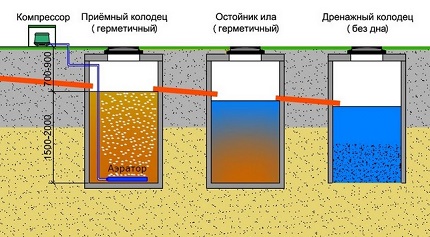
The risk of infection is low, but it is better to be cautious. In addition to supplying oxygen, the compressor has another useful function. A stream of compressed air enters the wastewater in such a way as to exert an active mechanical effect on them.
As a result, the effluents are mixed, which causes the grinding of solid inclusions and increases the speed of their processing.
Thus, the presence of a compressor in a septic tank increases its efficiency and the degree of wastewater treatment. But it should be reckoned with the need to bring power to the septic tank. As a result, the main advantage of homemade septic tanks is lost - non-volatility.
But problems due to power outages are unlikely to occur, especially if such situations rarely occur. If the compressor is turned off for a while, the sewage system will work in the previous mode, overflow to the device is usually not threatened. Although during prolonged blackouts, the level of effluents in wastewater treatment plants should be controlled.
Device Installation Procedure
It is not difficult to supplement the design of the septic tank with a compressor, but you still have to work hard. If septic tank two-chamber, it is better to add a third compartment to it, intended for aeration of drains and called aeration tank. It is here that the wastewater will be saturated with air and treated with aerobic microorganisms.
To do this, you will have to go through all the stages of creating a septic tank: dig a foundation pit, install an airtight one plastic container, concrete or other suitable material, connect it to the sewer leading from the house, connect overflow with other sections of the septic tank, install the cover, etc.
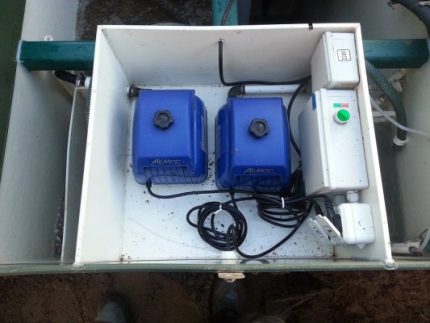
It is better to mount the compressor in the upper part of the tank, and not outside, so that the device is reliably protected from the weather. To do this, inside, near the lid, make a special shelf, on which subsequently put the compressor.
It will be even more reliable to make a more insulated compartment to protect the device from accidental wetting and other damage.
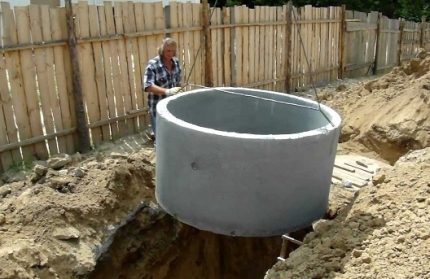
A hole must be provided for the compressor in the cover. You will also need another hole through which air will flow into the compressor.
Inside the aeration tank, you need to install a plastic pipe. Its lower end should be hermetically sealed, and the walls should be provided with perforations. It is usually enough to make about three hundred holes or a little less.
Make it better to drill with a two-millimeter drill. Through these openings, compressed air will enter the wastewater column, saturating them with oxygen and crushing large solid waste. The holes should be separated by approximately equal distances so that the air is evenly distributed. The upper part of the pipe is connected to the compressor using a hose.
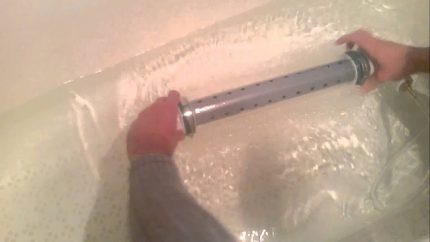
When all the elements are prepared, the following steps should be performed:
- Lower the aerator into the aeration tank.
- Install the compressor in the space provided for it.
- Connect the aerator with a hose to the compressor outlet.
- Connect the device to power.
- Turn on the compressor.
- Close the lid of the septic tank.
Now it remains only to regularly inspect the device and periodically, approximately twice a year, clean the air filter. Performing this operation is not difficult.The location of the filter is indicated on the device diagram in the manufacturer's instructions.
It is necessary to unscrew the protective cover, usually fixing bolts hold it. Then carefully remove the filter, rinse and dry it. After that, the cartridge is put in its original place and closed with a lid.
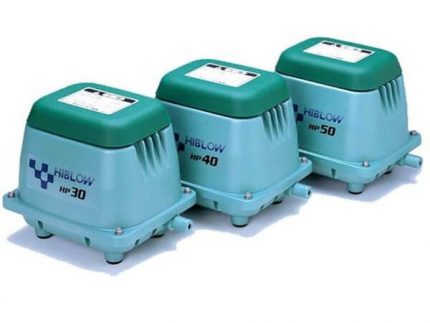
If during the inspection of the septic tank it is found that the working compressor is noisier than usual or if any extraneous noise is detected, this is cause for concern. If you leave it as it is, the compressor will soon break down.
Sometimes a standard air filter cleaning helps. But if the noise has not decreased, you should invite a specialist to diagnose the problem or seek warranty service.
If the septic tank is in the country or in a country house where the sewerage is not used all year round, it is necessary to produce septic tank preservation, with mandatory shutdown and removal of the compressor.
How to choose a suitable model?
The requirements for a compressor designed for operation in a septic tank are not so great. The air quality at the outlet can be almost any, the main thing is that it contains the oxygen necessary for bacteria. Therefore, expensive models equipped with filters and sophisticated automation can not even be considered.
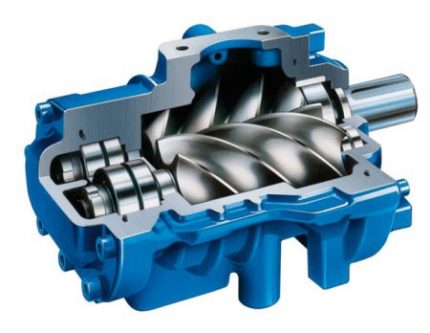
Given the conditions in which the compressor will have to function, high requirements are imposed on such characteristics as:
- reliability;
- ability to tolerate negative external influences;
- resistance to corrosion;
- simplicity in operation;
- reasonable price;
- maintainability;
- low noise, etc.
In addition, it is necessary to take into account the performance of the compressor, its design features and operating principle, as well as the outlet pressure or compression ratio.
The fact is that the air flow coming from the compressor to the aerator experiences resistance from the side of the water column that is inside.
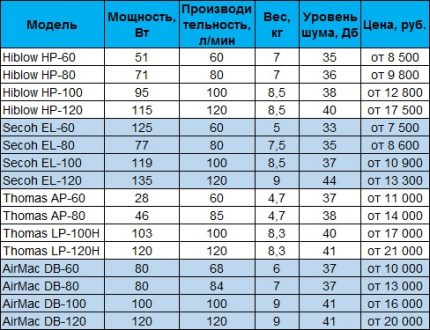
If the compression ratio is low, air simply cannot overcome the resistance of water, i.e. the drains will not be aerated at all, or the process will not be intensive enough.
The deeper the septic tank, the higher the resistance the compressor will have to overcome. Calculating the resistance is simple, for every meter of the depth of the tank you need the pressure at the outlet to one atmosphere.
The depth of the septic tank rarely exceeds two meters, so you can safely choose a compressor with a compression ratio of about two atmospheres. Compressor performance is an indicator that reflects how much air a device can move per unit of time.
The higher this indicator, the more powerful the engine is used in the device and the more electricity it consumes.
Although usually the power consumption for such devices is relatively small. While servicing the septic tank, no one has yet gone bankrupt. A compressor with a low performance for a septic tank will not work. If the air velocity is small, the drains will not be saturated enough with oxygen.
As a result, the environment inside the septic tank will be unsuitable for aerobic bacteria, microorganisms will not be able to process waste and will die over time. Do not take a compressor with excessively high performance. Such devices are more expensive, and can complicate the functioning of treatment facilities.
If air is pumped too quickly into a sealed aeration tank, an excessive pressure will build up inside.Such an environment can also be detrimental to aerobic bacteria. If you still have to use a high-performance compressor, you need to use it for short periods, constantly turning it on and off.
This creates an increased risk of damage to the device, and is simply inconvenient. You can use a high-performance compressor only as a temporary option, in the future it must be replaced with a more suitable unit. To determine the compressor performance, it is necessary to take into account the volume of the aeration chamber chamber.
You can focus on the following indicators:
- For a 2-3 cubic meter aeration tank, you need a compressor with a capacity of 60 l / min or less;
- For an aeration tank of 4-5 cubic meters, a compressor with a capacity of 80 l / min is needed;
- For an aeration tank of 6 cubic meters or more, a compressor with a capacity of at least 120 l / min is needed.
If the compressor is selected correctly, it will need to be turned on for a long time. Before buying, you should make sure that the selected model is designed specifically for this mode of operation. Depending on the principle of action, piston, centrifugal, diaphragm and screw compressors are distinguished.
Piston devices move air through a piston moving inside the housing. This is a simple device that is not too demanding on operating conditions. But piston units quickly overheat, have a low efficiency and work too noisy. Not the best choice for a septic tank.
Centrifugal compressors demonstrate excellent performance and would be well suited for autonomous sewers, if not for large sizes. Compact devices of this type are rare and expensive, so this option is almost never considered. Screw compressors are much better suited for such purposes.
The working element here is two screw-shaped rotors that effectively move air flows inside a special chamber. They are characterized by a high degree of air compression and excellent efficiency. They are reliable and profitable, can work around the clock. But with all the advantages, screw compressors are of high price.
In membrane devices, air is moved by a membrane or diaphragm controlled by an electromagnet. This is another great option for a septic tank. The device is cheaper than screw counterparts. The compression ratio is small, but it will fully satisfy the needs of the septic tank.
These compressors are easy to operate, well tolerate the effects of external factors, have suitable performance, have compact dimensions. For home-made septic tanks, membrane compressors are most often taken.
The most popular compressors on the market are Japanese-made Hiblow compressors. They are widely used in the configuration of local treatment plants for industrial production and are suitable for homemade aeration tanks.
These devices are highly reliable, their performance can reach 200l / min, but there are also less powerful models that are suitable for ordinary septic tanks.
German Thomas compressors are traditionally reliable and durable. Their advantages include an increased level of waterproofing, as well as reduced electricity consumption. Among the less expensive options are AirMac products made in Korea. In terms of quality, they are not inferior to expensive counterparts, VOC manufacturers willingly complete their devices with them.
Common breakdowns and repairs
The cause of compressor failure can be a number of reasons:
- Frequent and sudden voltage drops in the mains.
- Septic tank overflow or flooding.
- Natural wear of individual elements.
Often, appliances become unusable due to mechanical damage: inaccurate extraction from a septic tank before preserving the system for the winter, falls, etc.
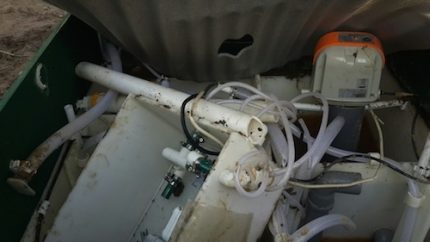
Eliminating the negative effects of power surges in the power grid is relatively simple. To do this, just install the stabilizer.
Owners of membrane compressors are forced to replace a membrane that fails due to normal wear and tear approximately every five years.
Such repairs can be done independently by following these steps:
- Disconnect the compressor from the power supply and from the aerator.
- Unscrew the fixing bolts and remove the cover of the device.
- Remove the soundproof cover.
- Remove elements that block access to the membrane.
- Unscrew retaining membrane cap fasteners.
- Remove the cover.
- Unscrew the center nut.
- Remove the membrane unit and disassemble it.
- Replace worn membranes with new elements.
- Reassemble the diaphragm block and reinstall it.
- Assemble the compressor in the reverse order.
Detailed repair recommendations and a description of the nuances can be found in the instructions and technical data sheet of the product. For many models, special repair kits containing a set of new membranes are sold. An ordinary replacement screwdriver or Phillips screwdriver is usually sufficient for a membrane replacement tool.
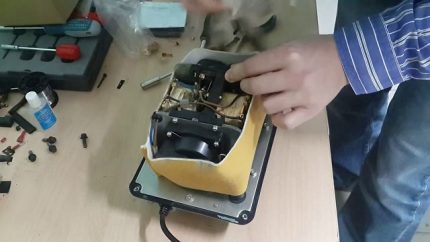
Conclusions and useful video on the topic
An overview of one of the Niblow compressor models can be found here:
This video presents the experience of comparing various compressor models:
How to replace the membrane in the Niblow compressor yourself:
A compressor is a great way to upgrade a conventional two- or three-chamber septic tank. A correctly selected model will significantly improve the operation of autonomous sewage and improve the quality of wastewater treatment. But keep in mind that additional work to create an aeration tank can take a lot of time and effort.
After reading the material, there were questions about how to choose or repair a compressor for a septic tank? Please write them in the comments to this article, and we will try to respond to them promptly.

 Overview of the Eco-Grand septic tank: device, principle of operation, advantages and disadvantages of the system
Overview of the Eco-Grand septic tank: device, principle of operation, advantages and disadvantages of the system  Overview of the septic tank “Flotenk”: characteristics, operating principle, installation + analysis of modifications
Overview of the septic tank “Flotenk”: characteristics, operating principle, installation + analysis of modifications 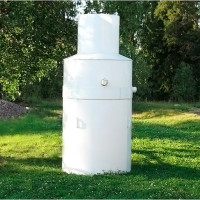 Overview of the cedar septic tank: device, principle of operation, advantages and disadvantages
Overview of the cedar septic tank: device, principle of operation, advantages and disadvantages  Rules for servicing a septic tank in winter: cleaning and maintenance
Rules for servicing a septic tank in winter: cleaning and maintenance 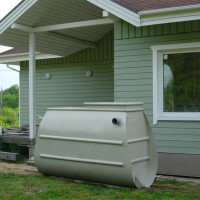 Overview of the Tver septic tank: device, principle of operation, advantages and disadvantages
Overview of the Tver septic tank: device, principle of operation, advantages and disadvantages 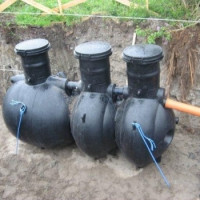 The device of a septic tank: the principle of operation and basic organization schemes
The device of a septic tank: the principle of operation and basic organization schemes  How much does it cost to connect gas to a private house: the price of organizing gas supply
How much does it cost to connect gas to a private house: the price of organizing gas supply  The best washing machines with dryer: model rating and customer tips
The best washing machines with dryer: model rating and customer tips  What is the color temperature of light and the nuances of choosing the temperature of the lamps to suit your needs
What is the color temperature of light and the nuances of choosing the temperature of the lamps to suit your needs  Replacement of a geyser in an apartment: replacement paperwork + basic norms and requirements
Replacement of a geyser in an apartment: replacement paperwork + basic norms and requirements
Good afternoon! There is a three-chamber septic tank made of concrete rings, in each chamber there are 6 rings. A compressor and aerator are installed in the first chamber, at the overflow from the 2nd chamber to the 3rd biofilter.
Question to experts, do I need an aerator in the 2nd chamber? And at what depth is the aerator installed correctly?
First of all, I will attach a scheme of three septic tanks with detailed instructions, so that it is more clearly and clearly. It is possible that in the future someone will have a similar question.
Now the actual explanations with the scheme:
1. Outlet pipe for sewage;
2. A tee under PND pipes;
3. Primary sedimentation tank;
4. Aerotank;
5. The drainage well;
6. HDPE pipe of the required diameter;
7. Gravel and crushed stone.
I also attach a diagram for the aeration system:
1. The compressor;
2. Tubes made of silicone;
3. Membrane diffuser.
Membrane diffusers need to be located a meter from the bottom of the aeration tank, taking into account the performance of the system, their number can reach up to three pieces. I recommend membrane diffusers that are used in fisheries pools.
Good afternoon! Tell me, what is better compressor or pump for Los?
Good day, Natalia.
A compressor cannot be better or worse than a pump and vice versa. They have different purpose:
1. The compressor is designed to pump oxygen into the sewage bioprocessing section. It is necessary for aerobic microorganisms, which in turn provide deep cleaning up to 98%. Details can be found in the article “Bacteria for septic tanks“.
2. A septic tank pump is used to pump already treated effluents into a ditch or filter well subject to counterclone in the direction of unloading.
The second application is as an emergency pump-down during a large one-time discharge, in order to protect against electrical equipment short circuit if it is installed directly in the septic tank.
The types and features of sewage pumps can be found in the article about sewage pumps, guidelines for their choice and features of operation.